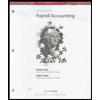
1.
Introduction: Take-home pay to an employee means the amount paid to an employee against their salary after deducting all the voluntary contributions and withholdings for which the employee is liable.
To compute: Net pay for the eight days work.
2.
Introduction: Payroll payment means the payment made by the employer against the services taken from an employee. It includes all the payment which is made to employee and any other person on behalf of employee.
To record:
3.
Introduction: Payroll tax expense is the amount paid by the employer to the internal revenue service against the employee gross pay.
To record: Journal entry of the payroll tax expense.
4.
Introduction: Sales tax is the tax imposed on person selling the goods and services. It is paid on an amount of sales after deducting discount and the credit of the taxes paid on purchase is available to the assesse.
To record: Journal entry for the merchandise sold having sales tax.
Want to see the full answer?
Check out a sample textbook solution
Chapter 9 Solutions
Gen Combo Ll Financial Accounting: Information For Decisions; Connect Ac
- Carlisle Manufacturing, which uses a calendar year, purchased a machine for $60,000 on January 5, 2015. It estimates the machine will have a useful life of 10 years and a $6,000 residual value. The machine is expected to produce 250,000 units during its useful life. The actual number of units produced were 22,000 during 2015, 31,000 during 2016, 24,000 during 2017, and 30,000 during 2018. Using the straight-line method, what is the book value at December 31, 2017?arrow_forwardWhat is your capital gains yield on this investment for this financial accounting question?arrow_forwardWhat is the weighted average cost per unit for July on these general accounting question?arrow_forward
- Arden Manufacturing uses process costing. At the beginning of March, there were 1,200 units in beginning inventory, 45% complete. During the month, 9,500 units were started. At the end of March, 600 units remained in ending inventory, 80% complete. How many units were completed during the month of March?arrow_forwardA warehouse with an appraisal value of $145,320 is made available at an offer price of $168,750. The purchaser acquires the property for $40,500 in cash, a 90-day note payable for $26,500, and a mortgage amounting to $62,900. What is the cost basis recorded in the buyer's accounting records to recognize this purchase? a) $168,750 b) $145,320 c) $129,900 d) $121,460arrow_forwardEvergreen Manufacturing uses a job-order costing system. The company estimates: Total direct labor hours for the year: 120,000 • Fixed manufacturing overhead: $600,000 Variable overhead rate: $2.50 per direct labor hour Job 307 details: Direct labor hours for the job: 80 Direct labor cost: $6,000 • Direct materials used: $950 What is the total job cost for Job 307?arrow_forward
 College Accounting, Chapters 1-27 (New in Account...AccountingISBN:9781305666160Author:James A. Heintz, Robert W. ParryPublisher:Cengage Learning
College Accounting, Chapters 1-27 (New in Account...AccountingISBN:9781305666160Author:James A. Heintz, Robert W. ParryPublisher:Cengage Learning College Accounting (Book Only): A Career ApproachAccountingISBN:9781337280570Author:Scott, Cathy J.Publisher:South-Western College Pub
College Accounting (Book Only): A Career ApproachAccountingISBN:9781337280570Author:Scott, Cathy J.Publisher:South-Western College Pub College Accounting (Book Only): A Career ApproachAccountingISBN:9781305084087Author:Cathy J. ScottPublisher:Cengage Learning
College Accounting (Book Only): A Career ApproachAccountingISBN:9781305084087Author:Cathy J. ScottPublisher:Cengage Learning Century 21 Accounting Multicolumn JournalAccountingISBN:9781337679503Author:GilbertsonPublisher:Cengage
Century 21 Accounting Multicolumn JournalAccountingISBN:9781337679503Author:GilbertsonPublisher:Cengage College Accounting, Chapters 1-27AccountingISBN:9781337794756Author:HEINTZ, James A.Publisher:Cengage Learning,
College Accounting, Chapters 1-27AccountingISBN:9781337794756Author:HEINTZ, James A.Publisher:Cengage Learning,





